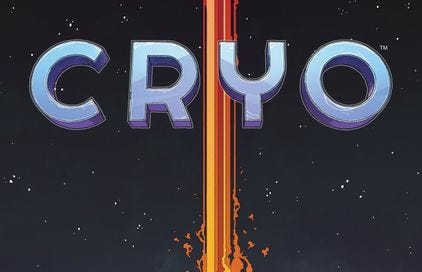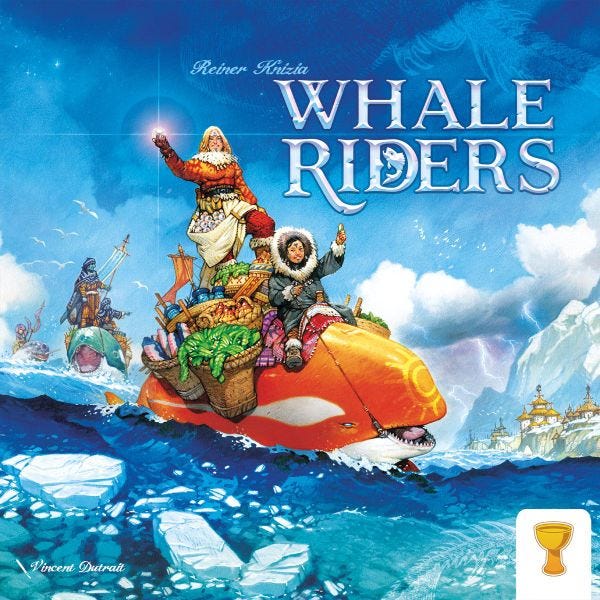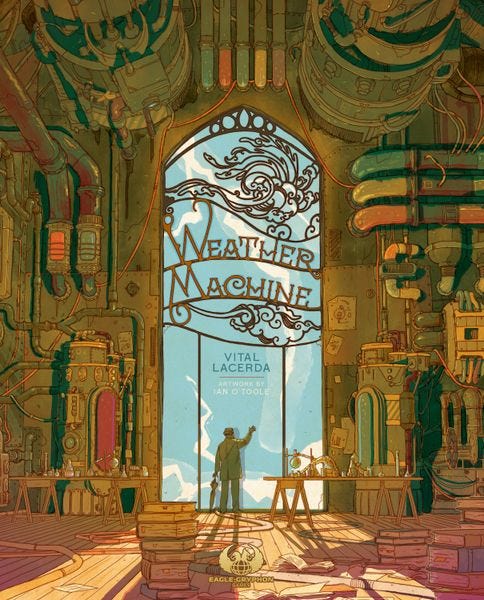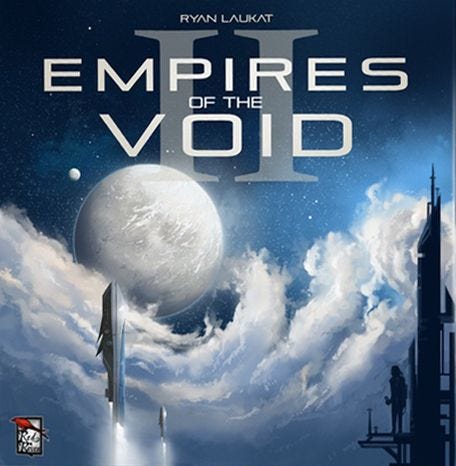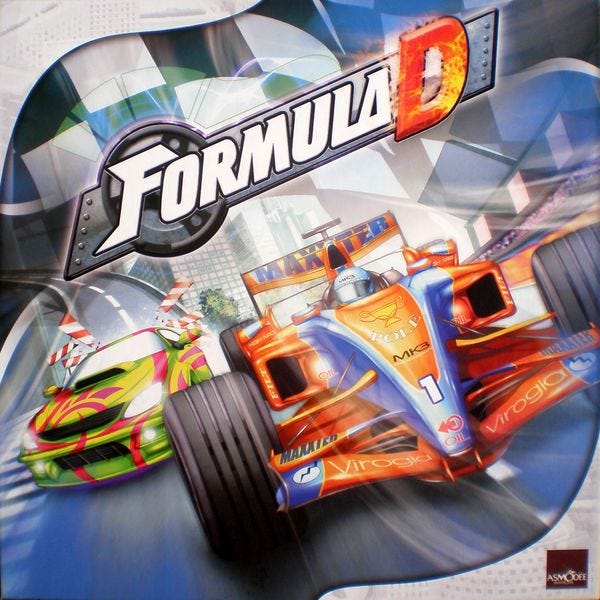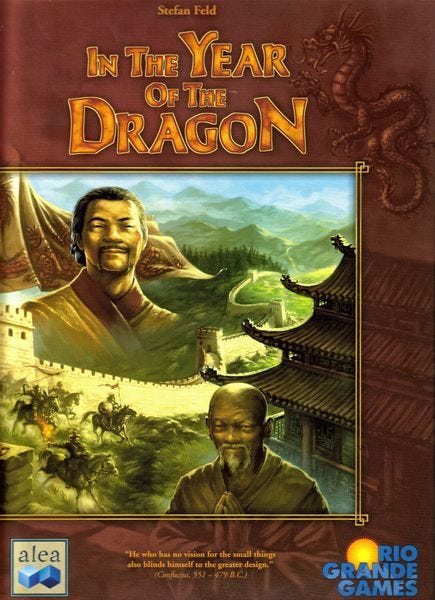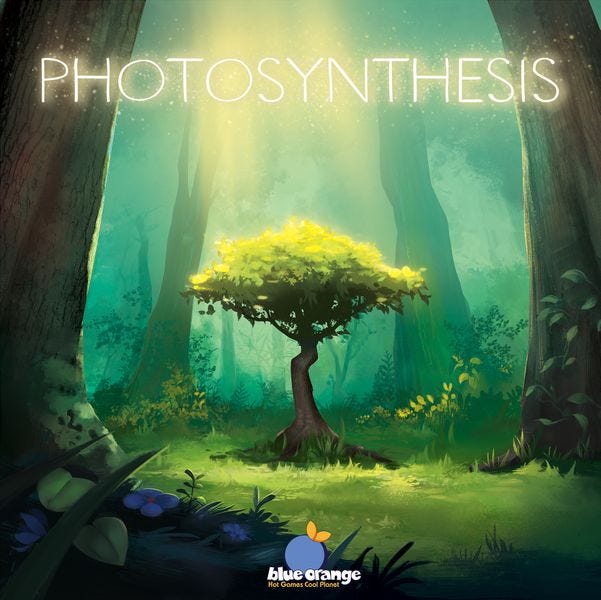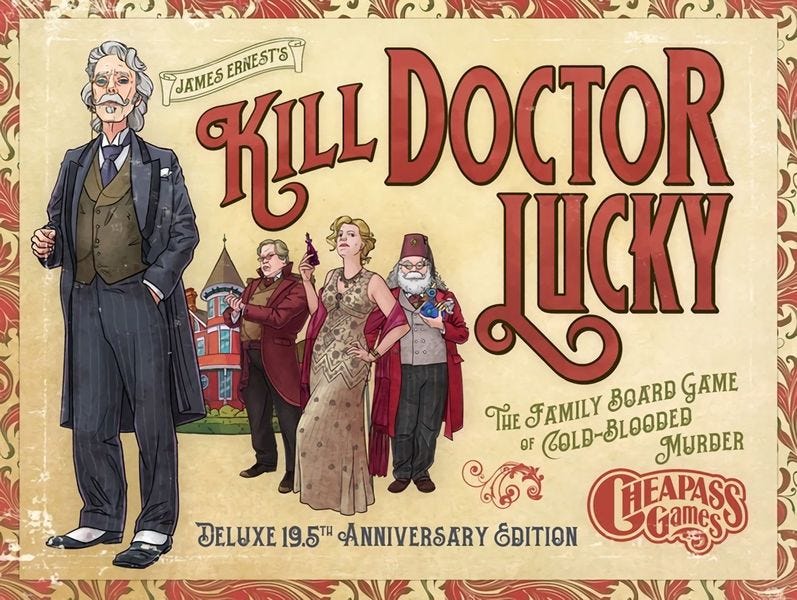What do you think so far? We’re starting to hit the “doldrums”, but there’s some great games in here! In fact, this whole list is made up of great games!
80. Cryo
Players: 2-4 (Best 3)
Time: 60-90 mins
BGG Weight: 2.78
Designed by Tom Jolly of Wiz-War fame and Luke Laurie (Dwellings of Eldervale, Whistle Mountain), Cryo seemed to fly under the radar. You’ve crashed on a planet that is inhospitable after an act of sabotage on your spaceship. You must send out your drones to save your people in cryostasis, gather resources and establish colonies in the underground before the sun sets and anyone left behind perishes.
It plays a lot like Laurie’s better know Dwellings of Eldervale, with area majority, worker placement and retrieval. You cap out at three workers and the timing on bringing back your workers really matters. It doesn’t have the table presence, but I actually really enjoy the game play here more. As much as I love playing with the screaming monster minis in Eldervale, the game feels more like a way to play with cool toys than the tightly wound Cryo.
It’s also easier to get to the table, plays quicker and has more cohesive rules. The thematic integration feels better to me as well. I still own both games, but I find myself reaching for Cryo more often.
79. Whale Riders
Players: 2-5 (best 4)
Time: 30-45 mins
BGG Weight: 1.83
Reiner Knizia is the most prolific, published board game designer of all time. He’s the Bob Pollard of cardboard. He’s got some 700 credits to his name on BGG, even though many of those are reskins or a reimplementation of an earlier work. You’re working your way down the coast and back up on the, well, back of your whale.
The game is perfect for families, as the rules are relatively simple. You have two actions each turn and you can slowly work your way down the coast harnessing more resources and buying power or racing down for the chance at something bigger at the risk of passing things you might need. The game ends once all the pearls are purchased and whoever has the most wins.
The game is colorful and hits the same feelings a show like Hilda does. I wish I had had games like this when I was a child. The industry has made huge leaps in family weight games, but I really appreciate someone like Knizia who has an ability to design excellent games for gamers of all skill and experience level. This is a game that is easy to play, but has a lot to think about for more experienced gamers. It is over in the right amount of time and can support up to 6 players, but I think it is a little long at that point.
78. Weather Machine
Players: 2-4 (Best 3)
Time: 60-150 mins
BGG Weight: 4.59
I would say this is the first TRUE heavyweight on the list. Twilight Imperium has a big teach and a long playtime, but I think it gels relatively quickly for how long the game is. When it comes to Vital Lacerda games, I am still struggling at the end to make sure I’ve made the right decision.
Adrianne found a love of heavy games on the Dice Tower Cruise last year, in large part due to Lacerda’s elegant design. Weather Machine is probably his clunkiest game, but until I get Vinhos or On Mars to a table, it’s got a place on this list.
You are working in tandem with the other players to build a weather machine. As a part of Professor Sêni Lativ’s team, you try to manipulate the weather for ideal situations while managing the negative side effects of using the machine in questions.
The thematic integration isn’t nearly as tight as some of Lacerda’s other work and the game can be a little confusing. That’s less than ideal in a game that demands so much of the player’s attention as is. But, it is still a masterclass in game design and if you want a worker placement game that really makes you drill down on efficiency, this is for you.
It doesn’t hurt that the theme is so fun.
77. Empires of the Void II
Players: 2-5 (best 3)
Time: 90 min-2 hr
BGG Weight: 3.46
This would be higher on my list, but there’s another game that does a lot of what this game does better. This is Ryan Laukat’s take on 4x. Laukat has a distinct art style and almost always solid game design. He tried to make the 4x genre accessible and quick with Empires of the Void. The sequel takes the best parts of the game and the expansions, refines the whole process and makes one of the best bite sized 4x space games on the market.
While the combat isn’t as satisfying as Twilight Imperium, the exploration is always top notch in Laukat’s games. It’s what he’s best at. It is also easier to set up and play than a lot of other games in this space. You’ve got a lot of paths to victory and the game has an accelerated power ramp that rewards players while cutting out a lot of the excess. This is a relatively lean game.
If you are looking for an entry point into this style of game, this would be my first recommendation. I think the rules are easy enough for newer players and the commitment isn’t intimidating. It is also more affordable than a lot of games in the genre.
76. Formula D
Players: 3-10 (Best 5-8)
Time: 1 hr
BGG Weight: 1.98
I don’t care for racing in general, but there’s something really exciting about racing games. I still have yet to play Heat: Pedal to the Metal, so it may eventually knock this game from my collection entirely, but when you have a group of people together this is a great go to.
You change gears and depending on what gear you’re in dictates what dice you can toss. There are turns you don’t want to take too fast and straightaways where you want to go as fast as possible. The game does have a more involved mode with asymmetrical characters and upgrades, but I find the base game to be more my speed. Throw your dice and live and die with the results.
You can burn out, but that almost always happens at the very end of the game when people are pushing to win the race and that risk/reward really makes the end game exciting. I almost never win, but I love the Formula One simulation and when it hits the table everyone leaves exhilarated.
75. In the Year of the Dragon
Players: 2-5 (best 4-5)
Time: 75-100 mins
BGG Weight: 3.09
Probably a surprise Feld pick, In the Year of the Dragon was an earlier work from one of the premiere German designers. Germany is, for a lot of people, the pinnacle of board game design. Feld is one of the biggest fish in one of the biggest ponds. The game is set in the year 1000 and plays over twelve rounds. For some players, the game can feel bleak and unrelenting, you’re constantly facing tragedies and must do your best to survive.
That’s where the game shines for me. Risk mitigation can make you feel like you’re never doing enough, but a game that forces you to make the best choice and live with the outcome is one that stands out for me. Too many games give you a plethora of positive outcomes with little risk for making the right choice. Or they are punishing to players who don’t make the perfect choice. In the Year of the Dragon walks that tight rope excellently for me.
Your turns are simple, you pick an action and play a person card. When the month ends, an event is triggered that may cost you people, money or reward you for careful planning. This is a game that requires you to plan ahead, you know what bad thing is coming. But having a well executed strategy come to fruition is so satisfying. It also features the same bland art work that litters most Feld games.
74. Photograph
Players: 2-4 (best 3)
Time: 20 mins
BGG Weight: 2.1
You’re taking a stroll in Japan in 1960s and taking pictures of what you see. The number of cards you draft each round dictates how many cards you’re going to play that turn. When you draft cards, they maintain the order they entered your hand with one exception. Every turn you’ll wind the film and move a card forward from the back of your hand to the front.
Cards are played in ascending or descending order from the first card you play in each color. If you play out of order or too far from the previous number, you suffer a penalty. Cards in the drafting tableau are split between face up and face down. The facedown numbers show the color of the card and a range that the card might fall into.
You pick a row and a direction and can draft 1-3 cards. Halfway through the game, your hand size is cut effectively in half. You’ll play all but one card in your hand by the end of the game. There are rewards for being the first to get a set number of cards in a certain color. The art is whimsical and the game play is engaging and brief. This is a great filler game and something I find enjoyment with every time I play.
73. Reef
Players: 2-4 (best 2)
Time: 30-45 mins
BGG Weight: 1.81
Emerson Matsuuchi is one of the best designers who never gets a shoutout. His games are well regarded, but I don’t hear his name as much as some of the bigger designers and none of his games are currently in the top 100. But if you play one, you’re probably going to love it.
His games are hyper accessible, both in gameplay and graphic design. Reef is no different. It looks like a child’s learning toy as much as a board game, with the colorful plastic reef pieces, but the gameplay is fantastic. You can draft from four cards into your hand (with a limit of four cards) or play a card that will allow you to get two pieces and score points if you match the pattern on the card. Reefs can grow to a height of four pieces and only the top piece of the reef matters for scoring.
When the reef pieces or deck runs out, the game is over and the player with the most points wins. This is an abstract game through and through, but the rules are simple. The game sets up and breaks down quick. It is over and you can play it to warm up or cool down a session of games. It also has fantastic table presence.
72. Photosynthesis
Players: 2-4 (best 3)
Time: 30 min-1 hr
BGG Weight: 2.26
Hjalmar Hach is another designer that doesn’t get a lot of attention. I have yet to play his Evergreen, which is rumored to be a better refinement on my number 72 game, Photosynthesis. The game is simple, you’re fighting for sunlight in a forest. Trees grow taller and block out the light for other trees, but you score points for chopping them down when they get taller. The sun moves each round meaning this turn you could be blocking your foes, but next you could be denied that sweet sunshine.
Where you place and when to fell your trees makes up a lot of the plant warfare of this area control game. A lot of criticism is lobbed at the game over it’s viciousness, but I think the game is over so quick that I never really feel the sting of betrayal in the way I do in Diplomacy. It is also cool to see your trees grow over the course of the game.
There are other games that scratch this itch better for me, but I will always have a soft spot for Photosynthesis.
71. Kill Doctor Lucky
Players: 3-6 (best 5)
Time: 45 mins
BGG Weight: 1.64
This is a game that is powered by nostalgia. While I’ve been a board gamer pretty much my whole life, Kill Doctor Lucky was my first obscure hit with my friends and family. This was the one that pushed the door open.
A clever inversion of clue, you’re trying to get the bad doctor alone in a room and finish him off for good. Everyone has their reasons for wanting him dead and players can use their resources from stopping your attempt. Eventually, someone will have enough spite built up (gained by having your previous attempts thwarted) to finish him off once and for all.
Planning how to get the doctor alone and when to use certain murder weapons, coupled with the excellent flavor of the game, means this game is usually a hit. It isn’t a game I reach for often anymore, for the most part because I have enough people that want something a little meatier to play, but this is one of the most fun transition games from classic family games to modern strategy games to this day.
In case you missed it:

